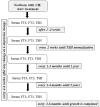Primary congenital hypothyroidism: a clinical review
- PMID: 40862110
- PMCID: PMC12371337
- DOI: 10.3389/fendo.2025.1592655
Primary congenital hypothyroidism: a clinical review
Abstract
Congenital hypothyroidism (CH) is the most common neonatal endocrine disorder. It is one of the clinical conditions that has benefited most from the introduction of newborn screening 50 years ago, as clinical management has changed and long-term consequences have been significantly reduced. In areas where neonatal screening is active, most affected patients show a clinically normal phenotype and/or only mild symptoms. At the same time, thanks to a progressive reduction in the TSH level used as cut-off for neonatal screening, the number of cases of CH with gland in situ is increasing, while the number of patients with abnormal thyroid development has remained essentially unchanged over time. Furthermore, important changes are observed in managing patients with CH and gland in situ. On the one hand, they are subjected to genetic investigations to understand the underlying molecular mechanism; on the other hand, a reassessment of thyroid function is suggested starting from the sixth month of life if their L-thyroxine requirement is low. This review aims to describe the clinical approach to CH and to optimize the management and treatment of this disease.
Keywords: congenital hypothyroidism; dysgenesis; dyshormonogenesis; newborn screening for congenital hypothyroidism; thyroid gland.
Copyright © 2025 Cavarzere, Mancioppi, Battiston, Lupieri, Morandi and Maffeis.
Conflict of interest statement
The authors declare that the research was conducted in the absence of any commercial or financial relationships that could be construed as a potential conflict of interest.
Figures



References
-
- Van Trotsenburg P, Stoupa A, Léger J, Rohrer T, Peters C, Fugazzola L, et al. Congenital hypothyroidism: A 2020–2021 consensus guidelines update-an ENDO-European reference network initiative endorsed by the European society for pediatric endocrinology and the European society for endocrinology. Thyroid. (2021) 31:387–419. doi: 10.1089/thy.2020.0333, PMID: - DOI - PMC - PubMed
-
- Hoyes AD, Kershaw DR. Anatomy and development of the thyroid gland. Ear Nose Throat J. (1985) 64:318–33. - PubMed
Publication types
MeSH terms
Substances
LinkOut - more resources
Full Text Sources
Medical

